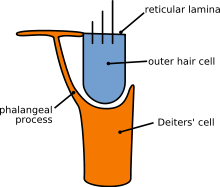Deiters cells
Deiters' cells, also known as phalangeal cells or cells of Deiters (English: /ˈdaɪtərz/), are a cell type found within the inner ear. They contain both micro-filaments and micro-tubules which run from the basilar membrane to the reticular membrane of the inner ear.[1]

In the mammalian cochlea, each outer hair cell stands on the soma of a cell of Dieters. What is not apparent in this diagram is that the phalangeal process is tilted out of the plane of this projection, such that its top is near the top of a different outer hair cell, further along in the directional of cochlear wave propagation.
These cochlear supporting cells include a somatic part, with its cupula, and a phalangeal process, which links the Deiters soma to the reticular lamina. The part of the phalanx which is included in the reticular lamina is the apex of the phalanx (phalangeal apex).
The cells are named for neuroanatomist Otto Deiters.
References
- Hall pp51
Bibliography
- Hall, James W. (2000) Handbook of otoacoustic emissions Singular Publishing ISBN 978-1-56593-873-1
- O. Deiters (1860) Untersuchungen uber die Lamina spiralis membranacea Henry & Cohen, Bonn
This article is issued from
Wikipedia.
The text is licensed under Creative
Commons - Attribution - Sharealike.
Additional terms may apply for the media files.